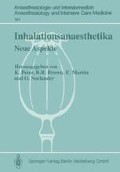Zusammenfassung
Die Effektivität der medikamentösen Beeinflussung von Schmerzen ist von 2 Größen abhängig:
-
1.
von der Qualität und Intensität des Schmerzes,
-
2.
von der Potenz bzw. Dosierung des verwendeten Schmerzmittels.
Access this chapter
Tax calculation will be finalised at checkout
Purchases are for personal use only
Preview
Unable to display preview. Download preview PDF.
Literatur
Backman LE, Löfström B, Widen L (1964) Electroencephalography in halothane anaesthesia. Acta Anaesthiol Scand 8:115–130
Berezowskyj JL, MacEwen JA, Adnerson GB, Jenkins LC (1976) A study of anaesthesia depth by power spectral analysis of the electroencephalogram (EEG) Can Anaesth Soc J 23:1–8
Bostem F, Hanquet M (1975) Untersuchungen des Verlaufs der Energiespektraldichte des Elektroenzephalogramms unter Halothan- und Enflurannarkose. In: Brückner JB (Hrsg) Inhalationsanaesthesie mit Ethrane. Symposion 1975 Berlin. Springer, Berlin Heidelberg New York
Brandt L, Pokar H (1984) Änderungen der EEG Aktivität nach Lachgasanaesthsie: Die postinhalatiorische Hyperaktivität. In: Schara J (Hrsg) Deutscher Anästhesie-Kongreß Wiesbaden 1. Springer, Berlin Heidelberg New York (Anästhesiologie und Intensivmedizin, Bd 161, S 37–45)
Brandt L, Beck H, Janzen R, Pokar H, Renz D (1981) EEG-Veränderungen durch Lachgas. Zentraleuropäischer Anästhesiekongreß Berlin 1981. G18/2:305
Brandt L, Fina M, Pokar H, Renz D (1982) Changes of electroencephalographic power spectal during nitrous oxide anaesthesia. Sixth European Congress of Anaesthesiology, p 336
Challen PD, Tobias MA (1983) EEG Fourier analysis during clinical anaesthesia: Halothane and enflurane. In: Bennetts FE (ed) Enflurane. Biomedical Information, New York
Doenicke A, Kugler J (1975) Wirkungen des Ethrane auf das zentrale Nervensystem In: Kreuscher H (Hrsg) Ethrane — neue Ergebnisse in Forschung und Klinik. Schattauer, Stuttgart, S 45–55
Eger EI II (1974) MAC. In: Eger EI II (ed) Anesthetic uptake and action. Wiliams & Wilkins, London
Eger EI II, Saidman LJ, Brandstater D (1965) Minimum alveolar anaesthetic concentration: A standard of anaesthetic potency. Anesthesiology 26:756–763
Grabow L (1981) Hirnfunktionen unter dem Einfluß der allgemeinen Anästhesie. Fischer, Stuttgart
Jasper HH (1958) The ten twenty electrode system of the International Federation Electoenceph. Clin Neurophysiol 10:371–375
Kugler J (1981) Elektroenzephalographie in Klinik und Praxis. Thieme, Stuttgart
Loomis AL, Harvey EN, Hobart GA (1937) Cerebral states during sleep as studies by human brain potentials. J Exp Psychol 21:127–144
Neigh JL, Garman JK, Harp JR(1971) The electroencephalographic pattern during anaesthesia with ethrane. Anaesthesiology 35:482–487
Oshima E, Shingu K, Mori K (1981) EEG activity during halothane anaesthesia in man. Br J Anaesth 53:65–72
Pichlmayr I, Lips U (1980) Halothane-Effekte Elektroenzephalogramm. Anaesthesist 29:530–538
Pichelmayr I, Lips U, Künkel H (1983) Das Elektroenzephalogramm in der Anaesthesie. Springer, Berlin Heidelberg New York
Quasha AL, Eger EI II, Tinker JH (1980) Determination and applications of MAC. Anesthesiology 55:315–334
Schwilden H, Stoeckel H (1980) Untersuchungen über verschiedene EEG-Parameter als Indikatioren des Narkosezustandes. Anasth Intensivther Notfallmed 15:279–286
Simon CW, Emmons WH (1956) EEG, consciousness and sleep. Science 124:1066–1069
Stochard JJ, Bickford G (1981) The neurophysiology of anaesthesia. In: Gordon E (ed) A basis and practice of neuroanaesthesia. Excerpta Medica, Amsterdam
Stoeckel H, Lange H, Burr W, Hengstmann JH, Schüttler J (1979) EEG-Spektralanalyse zur Dokumentation der Narkosetiefe, Prakt Anaesth 14:227–232
Tinker JH, Sharbrough FW, Michenfelder JD (1977) Anterior shift of the dominat EEG-rhythm during anesthesia in the Java-monkey. Anesthesiology 46:252–259
Editor information
Editors and Affiliations
Rights and permissions
Copyright information
© 1986 Springer-Verlag Berlin Heidelberg
About this paper
Cite this paper
Brandt, L. (1986). Die Beeinflussung des menschlichen Enzephalogramms durch Inhalationsanästhetika in äquipotenter Konzentration — Untersuchungen an freiwilligen Probanden. In: Peter, K., Brown, B.R., Martin, E., Norlander, O. (eds) Inhalationsanaesthetika. Anaesthesiologie und Intensivmedizin / Anaesthesiology and Intensive Care Medicine, vol 184. Springer, Berlin, Heidelberg. https://doi.org/10.1007/978-3-662-07905-8_9
Download citation
DOI: https://doi.org/10.1007/978-3-662-07905-8_9
Publisher Name: Springer, Berlin, Heidelberg
Print ISBN: 978-3-540-15968-1
Online ISBN: 978-3-662-07905-8
eBook Packages: Springer Book Archive

